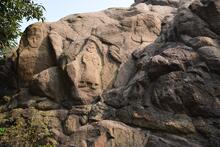The Date of Kongwangshan Reconsidered
Minku Kim - Assistant Professor, The Chinese University of Hong Kong
*Please note this event is scheduled to begin at 9:25am
Please register for this Zoom event here
The Buddho-Daoist group of bas-reliefs crudely carved on the cliff of Kongwangshan 孔望山 in Lianyungang 連雲港 (Jiangsu) has been widely reputed to date to the late Eastern Han (25–220 CE), following the report of the preliminary survey published in 1981 and the authority, among others, of the late Yu Weichao 俞偉超 (1933–2003). Rather recently, the date has been reaffirmed by the final site report published in 2010. But the controversy remains if these carvings are truly datable to the late second to the early third century, and thereby constitute the earliest and largest works of figurative representations themed in Buddhism and/or religious Daoism known across China.
The talk reexamines the chronology of these cliff carvings based on new insights. Several intrinsic factors loom large against the Eastern Han dating such as the ways how the bedrock was primed, or indeed, not primed, how a frontal figure is seated before a pingji 凭几 armrest-table, and so forth. Extrinsically, too, sinologists in the meantime need to acknowledge the possible belatedness of Indian prototypes available for China by at least half a century later en bloc than previously thought with the important recalibration of the Kaniṣkan Era proposed by Harry Falk in 2001 and 2004. With all these new parameters considered in full, the talk concludes that the Buddho-Daoist carvings of Kongwangshan cannot be dated to Eastern Han but the sixth century at the earliest.
Dr. Minku Kim is an assistant professor of Fine Arts at The Chinese University of Hong Kong. Previously he taught at the University of Minnesota-Twin Cities and was an Andrew W. Mellon Scholar in the Humanities at Stanford University.
He received his PhD from the University of California, Los Angeles, and both MA and BA from Seoul National University (South Korea). His research focuses on Buddhism and the cult of images in early medieval China, and is now completing his first monograph, Dolls and Idols: Statues in China before and after Buddhism.

